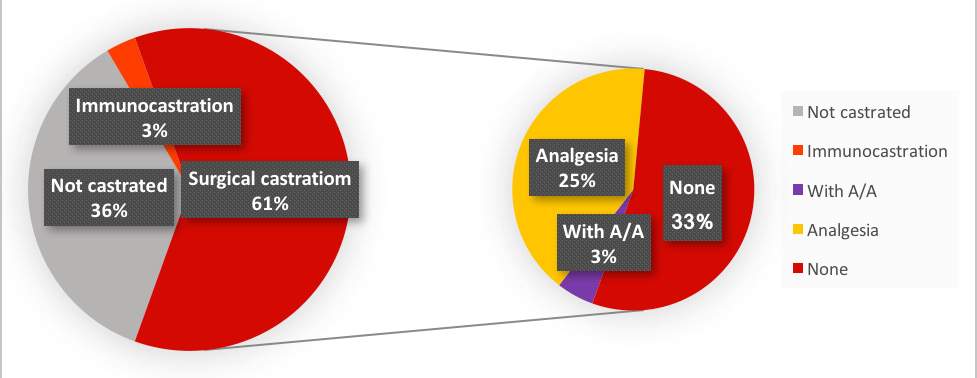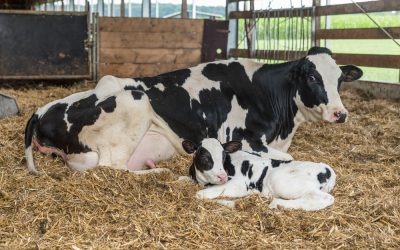N.De Briyne, C.Berg, T.Blaha, D.Temple
Many male pigs are surgically castrated in Europe. Often without any pain relief. While this is allowed by European legislation up to 7 days, this is a painful procedure and hence give rise to welfare concerns. To tackle this, in 2010, on the initiative of the European Commission and the Belgian Presidency, representatives of European farmers, meat industry, retailers, scientists, veterinarians – represented by the Federation of Veterinarians of Europe (FVE) and animal welfare Non-Governmental Organisations agreed upon the ‘European Declaration on alternatives to surgical castration of pigs’. The final goal of this Declaration is to phase out the surgical castration of pigs by 2018. But the Declaration also requested that from 1 January 2012, surgical castration of pigs shall only be performed with prolonged analgesia and/or anaesthesia.
In September 2015, FVE together with the European Commission started to analyse the situation with respect to the progress seen in the different countries following up the Declaration. The results collected from 24 EU countries show that approximately one third (36%) of male pigs is raised as entire male while the big majority (61%) of male pigs are still surgically castrated. Immunocastration is used in 3% of male pigs.
The majority of surgically castrated male pigs do not receive any pain relief. Nevertheless, post-operative analgesia (without anaesthesia though) is now increasingly used in many countries, probably partly due to the Declaration. The problem of analgesia alone is that the effectiveness of this method to alleviate the pain during male piglet castration is questionable. The use of both anaesthesia and analgesia is a common practice in a very limited number of EU countries.
Those results show that both deadlines (2012 and 2018) set by the Declaration are far from being met. Despite this, the Declaration has brought all stakeholders together around this issue and has contributed to an improvement in the number of pigs surgically castrated with some pain relief and raised as entire males.
As a priority to make further progress, a series of practical and effective analgesia and/or anaesthesia protocols should be mutually agreed at a national or EU level.
The percentage of male pig population immunocastrated is still very low. Notwithstanding, it appears a promising alternative to surgical castration. In some countries the production of entire males has been for long used and some other countries reported an increase in the number of pigs raised as entire males. Depending of the country, immunocastration and entire male production are foreseen as valuable alternatives to surgical castration although they will most likely never be able to replace surgical castration completely.
Customers in Europe are increasingly critical towards how the animals are raised and produced. Painful management practices such as castration provoke a strong public concern. Given the current economic context of many countries, it is unlikely that conventional pig farms will be able to follow the European declaration on pig castration unless it becomes mandatory in one way or another. Intervention strategies should help farmers and veterinary practitioners develop practical, welfare friendly and sustainable methods of keeping farmed animals. Implementing strategies to minimize pain and stress associated with pig castration is in this way connected to the future of the European pig sector.
THERE IS A NEED TO DEVELOP EFFECTIVE ANALGESIA/ANAESTHESIA PROTOCOLS
There is still a major bottleneck in the use of the combination of anaesthesia and analgesia during male piglet castration, the anaesthesia being the biggest constraint. As a priority to make further progress, a series of mutually agreed, practical and effective analgesia and/or anaesthesia protocols should be agreed at a national or EU level. These protocols should be cost effective, produce minimum stress and pain both during and after castration and be safe for both the handler and the piglet. The method should also ensure a quick recovery to minimize the risk of the piglet being crushed by the sow.
In 2016, a European consortium on the basis of a call of the European Commission (SANCO/2014/G3/026) started a study on the methods of anaesthesia and analgesia for all pigs and other alternatives for pigs used in traditional products -– called ‘CASTRUM’. The outcome of this study are available online.
IMMUNOCASTRATION MAY GIVE THE GREATEST BENEFIT TO THE ANIMALS
Immunocastration is used in a higher proportion of pigs in Belgium mainly due to the impact of a major Belgian retailer (Colruyt) who since end 2010 only accepts pork from pigs castrated by vaccination. The main limitation to immunocastration is linked to market issues and human error (vaccinating outside the recommended time period, missing a dose). Most retailers do not accept pork from immunocastrated pigs being afraid for poor public acceptance. However, in the case of Belgium, the acceptance of immunocastration led to a better welfare-friendly image of the retailer.

Figura: Percentage of male pigs and castration methods in the 24 countries surveyed.
THE COSTS AND BENEFITS OF RAISING ENTIRE MALES DEPENDS ON THE PERCENTAGE OF MALES WITH BOAR TAINT AT SLAUGHTERING
In Ireland, Portugal, Spain and the United Kingdom less than 20% of the pigs are surgically castrated. Most countries do not rear entire male pig due to the incidence of boar taint. Belgium, France, Germany, the Netherlands and Switzerland reported a significant increase in the number of pigs raised as entire males There is so far no international accepted and validated on-line method available for the measurements of boar taint in carcasses that throughout fulfils the requirement for a highly streamlined industry at the slaughterhouses.
The cost action IPEMA (Innovative approaches in pork production with entire males) deals with challenges in management of product quality, nutritional requirements, animal management an housing to reduce boar taint in entire males and addresses animal welfare issues.
Tabla: Percentages of entire, immunocastrated and surgically castrated males and castration methods used in the 24 countries surveyed by FVE
Country |
Whole males |
Immunocastrated |
Surgical castration |
Surgical castration method |
Pig population* |
||
| Castrated under anaesthesia and analgesia | Castrated with analgesia only (%) | Castrated without analgesia or anaesthesia | |||||
| % of total | % of total | % of total | % of surgically castrated | % of surgically castrated | % of surgically castrated | ||
| Austria | 5 | 0 | 95 | 1 | 72 | 27 | 2869 |
| Belgium | 15 | 18 | 67 | 3 | 6 | 91 | 6351 |
| R. Czech | 5 | 5 | 90 | 6 | 31 | 63 | 1548 |
| Denmark | 5 | 0 | 95 | 0 | 95 | 5 | 12402 |
| Estonia | 0 | 0 | 100 | 0 | 10 | 90 | 359 |
| Finland | 4 | 0 | 96 | 0,5 | 99 | 0.5 | 1258 |
| France | 20 | 0 | 80 | 0 | 50 | 50 | 13428 |
| Germany | 20 | 0,5 | 80 | 1 | 99 | 0 | 28046 |
| Hungría | 1 | 0 | 99 | 0 | 0 | 100 | 2935 |
| Iceland | 5 | 0 | 95 | 0 | 95 | 5 | 36 |
| Italy | 2 | 5 | 93 | 0,5 | 2,5 | 97 | 8561 |
| Ireland | 100 | 0 | 0 | 0 | 0 | 0 | 1468 |
| Lithuania | 0 | 0 | 100 | 0 | 0 | 100 | 368 |
| Luxembourg | 1 | 0 | 99 | 0 | 99 | 1 | 90 |
| Netherlands | 80 | 0 | 20 | 30 | 0 | 70 | 12013 |
| Norway | 1 | 1 | 99 | 99 | 0 | 1 | 1644 |
| Portugal | 85 | 2,5 | 12,5 | 0 | 0 | 100 | 2014 |
| Romania | 0 | 5 | 95 | 2 | 4 | 94 | 5180 |
| Slovakia | 0 | 10 | 90 | 0 | 12 | 88 | 637 |
| Slovenia | 1 | 0 | 99 | 1 | 9 | 90 | 288 |
| Spain | 80 | 5 | 15 | 1 | 7 | 92 | 25495 |
| Sweden | 0 | 6 | 94 | 24 | 76 | 0 | 1478 |
| Switzerland | 5 | 2,5 | 92,5 | 97 | 0 | 3 | 1573 |
| UK | 98 | 0,5 | 2 | 4,5 | 4.5 | 91 | 4383 |
| 2,542 | 75,333 | 11,271 | |||||
| Europe-24 average (median) | 2,7 (0,2) | 78 (95) | 11 (0.5) | 32 (7,5) | 50 (65) | 132920 | |
| Europe-24 (according to pig population) | 36% | 3,00% | 61% | 5% surgically castrated pigs | 41% surgically castrated pigs | 54% surgically castrated pigs |
REFERENCES
- Castrum Consortium 2017 Methods of anaesthesia and analgesia for all pigs and other alternatives for pigs used in traditional products, EU publication.
- Cost Action IPEMA http://www.ca-ipema.eu/
- De Briyne N, Berg C, Blaha T, Temple D, Pig castration: will the EU manage to ban pig castration by 2018? Porcine Health Management Journal, 2:29, 1-11 2016
- European Commission. European Declaration on alternatives to surgical castration of pigs. https://ec.europa.eu/food/animals/welfare/practice/farm/pigs/castration_alternatives_en
- Fredriksen B, Furnols MFI, Lundstrom K, Migdal W, Prunier A, Tuyttens FAM, Bonneau M. Practice on castration of piglets in Europe. Anim. 2009;3:1480–7.
- Rault JL, Lay Jr DC, Marchant-Forde JN. Castration induced pain in pigs and other livestock. Appl Anim Behav Sci. 2011;135:214–25.



